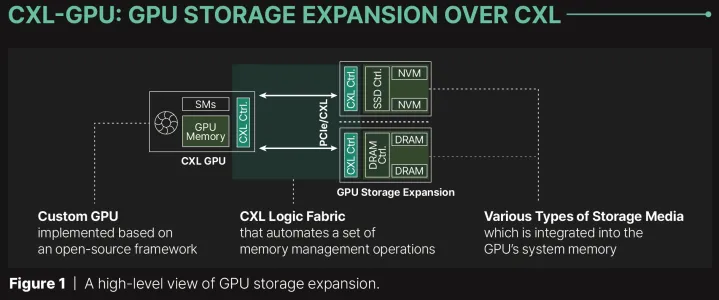In a groundbreaking development for the GPU industry, PCIe-attached memory is poised to revolutionize GPU memory capacity and performance. Panmnesia, a company backed by South Korea’s KAIST research institute, is pioneering Compute Express Link (CXL) technology, allowing GPUs to harness external memory resources through the PCIe interface.
Traditionally, GPUs like the RTX 4060 have been constrained by their onboard VRAM, leading to performance bottlenecks in memory-intensive tasks such as AI training, data analytics, and high-resolution gaming. CXL utilizes the high-speed PCIe connection to attach external memory modules directly to the GPU.
This approach offers a low-latency memory expansion solution, with performance benchmarks indicating significant improvements over conventional methods. Reports suggest that the new technology achieves double-digit nanosecond latency, a substantial reduction compared to standard SSD-based solutions.

Furthermore, this technology is not limited to traditional RAM. SSDs can also be utilized for GPU memory expansion, providing a versatile and scalable solution. This capability enables the creation of hybrid memory systems that combine the speed of RAM with the capacity of SSDs, enhancing performance and efficiency.

Get your weekly breakdown of the technology behind PC gaming
While CXL operates on a PCIe link, integrating this technology with GPUs presents challenges. GPUs lack the necessary CXL logic fabric and subsystems to support DRAM or SSD endpoints, making simply adding a CXL controller unfeasible.
GPU cache and memory systems only recognize expansions through Unified Virtual Memory (UVM). However, testing by Panmnesia revealed that UVM had the poorest performance among tested GPU kernels due to host runtime intervention during page faults and inefficient data transfers at the page level.
To address this issue, Panmnesia designed a series of hardware layers supporting key CXL protocols, consolidated into a unified controller. This CXL 3.1-compliant root complex includes multiple root ports for external memory over PCIe and a host bridge with a host-managed device memory decoder, connecting to the GPU’s system bus and managing system memory for direct access to expanded storage, eliminating UVM issues.
The implications of this technology are vast. For AI and machine learning, increased memory means handling larger datasets more efficiently, speeding up training times and enhancing model accuracy. In gaming, developers can push graphic fidelity and complexity boundaries without VRAM limitations.
For data centers and cloud computing environments, Panmnesia’s CXL technology offers a cost-effective way to upgrade existing infrastructure by attaching additional memory through PCIe, boosting computational power without extensive hardware changes.
Despite its potential, Panmnesia faces a challenge in gaining industry-wide adoption. Leading graphics card manufacturers like AMD and Nvidia do not currently support CLX and may never do so. Other industry players may develop their own PCIe-attached memory technologies for GPUs. Nevertheless, Panmnesia’s innovation represents progress in addressing GPU memory bottlenecks and has the potential to significantly impact high-performance computing and gaming.


